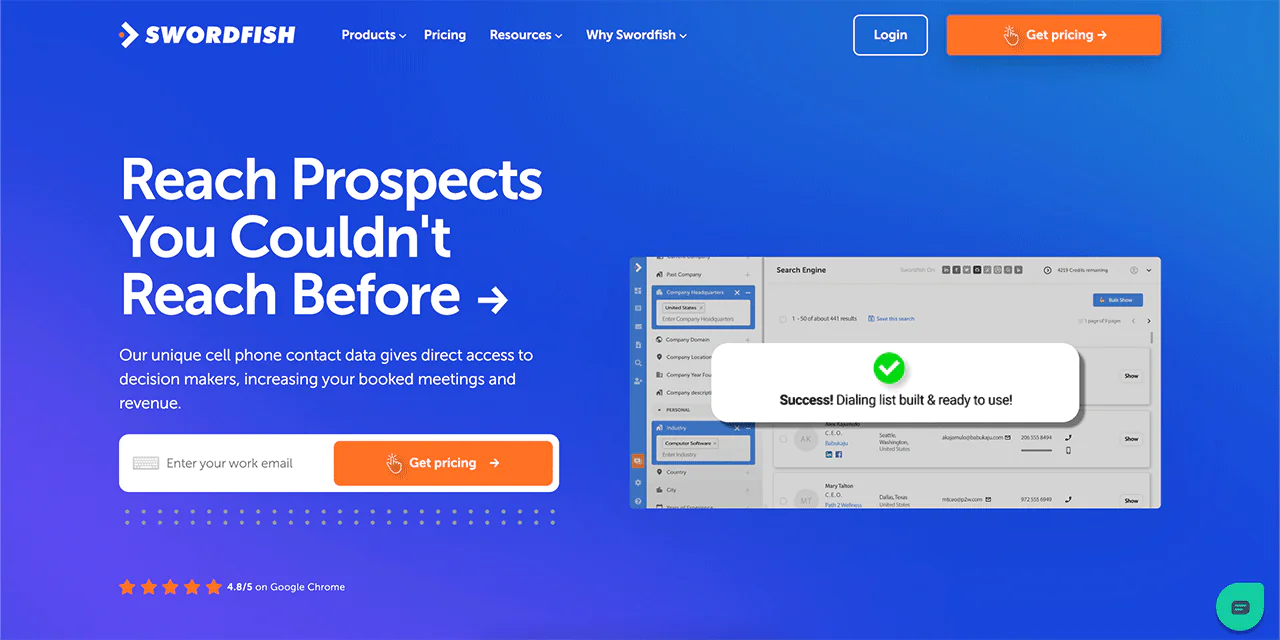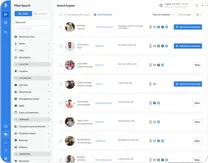
Is cold calling still relevant in today’s digital-driven sales environment?
This question often sparks debates among sales and marketing professionals.
Well, on one side, some argue that cold calling is a relic of the past, overshadowed by newer digital methods. On the other, many insist it’s still one of the effective sales strategies.
So, what’s the reality?
The truth is that cold calling continues to play a meaningful role in sales. It’s not just about making random calls; it’s a strategic approach to reach potential clients who haven’t yet expressed interest in a product or service.
Hence, in this article, we’ll show you that cold calling is still alive and kicking well in sales by highlighting 18 insightful cold calling facts. So, whether you’re a seasoned sales veteran or new to the field, these insights will enhance your understanding and approach to cold calling.
Let’s buckle up!
What is Cold Calling?

Cold calling is a proactive sales technique where representatives reach out to potential customers. It’s for those who have not shown prior interest in the specific products. For instance, Rain Group highlights that 92% of providers give valuable insights through cold calls about new products and services.
Generally, this method is unsolicited, which means the contact is unexpected from the recipient’s perspective. The primary goal of cold calling is to open a conversation with a potential customer, laying the groundwork for a future sale.
Also, this approach is more than just a random selection of phone numbers; it’s a targeted strategy. Sales professionals often use market research and customer profiles to identify prospects who are most likely to benefit from their offerings.
Even with the growth of digital marketing, cold calling continues to be an important method for salespeople. A study from Baylor University found that skilled sales professionals typically achieve one appointment or referral for every 209 cold calls they make. This highlights the need for persistence and resilience in cold calling.
Plus, it shows the potential effectiveness when executed correctly as well. The success of cold calling depends not just on the volume of calls made, but on the quality of the conversations. Also, the ability of the caller to connect with potential clients on a meaningful level.
Importance of Cold Calling
Cold calling is important because it allows direct, personal interaction with potential customers, helping to build relationships and gather immediate feedback. Here are some of its key benefits in detail:

Direct Engagement with Potential Clients
Cold calling stands out for its ability to facilitate direct and immediate communication with potential clients. This method bypasses the often impersonal nature of digital marketing, permitting sales professionals to engage in real-time conversations.
But it’s not just about pitching a product or service. It’s about creating a personal connection, which can be a decisive factor in building trust and interest.
Understanding Customer Needs Firsthand
One of the most significant advantages of cold calling is the direct insight it provides into the customer’s needs and challenges. Unlike digital surveys or analytics, which can offer a somewhat detached view, cold calling involves active listening and engaging.
This interaction enables sales professionals to tailor their approach based on real-time responses. It also leads to a more customer-centric approach that can significantly enhance the relevance and appeal of their offerings.
Immediate Feedback and Sales Opportunities
The immediate feedback in cold calling is unparalleled. Sales professionals can instantly gauge the reaction of potential clients to their pitch, which grants for quick adjustments and improvements.
This immediate response is not just about refining sales tactics; it also opens the door for instant conversions. When a call resonates well, it can lead directly to a sale.
Also, it can shorten the sales cycle dramatically compared to other methods that might require multiple touchpoints over a longer period.
Building Long-Term Relationships
Well, cold calling isn’t just about making an immediate sale. It’s a powerful tool for initiating long-term relationships with potential clients. By reaching out directly, sales professionals can lay the groundwork for ongoing communication.
This initial contact, even if it doesn’t result in an immediate sale, can plant the seeds for future business, referrals, or collaborations. It’s an opportunity to introduce the company and its values.
Plus, it creates a memorable impression that digital ads or emails often can’t match.
Market Research and Adaptation
Engaging in cold calling also serves as a real-time market research tool. Through conversations with potential clients, salespeople can gather insights about market trends, competitor activities, and emerging customer needs.
Moreover, this information is invaluable for adapting sales strategies for developing new products or refining services.
Unlike traditional research methods that often rely on static data, cold calling offers a dynamic and immediate way to gauge current market trends. This approach enables companies to quickly adapt and respond to evolving customer preferences and shifts in industry dynamics.
13 Eye-Opening Facts About Cold Calling Every Salesperson Should Know
Cold calling, a staple in the sales industry, encompasses various facets that contribute to its effectiveness and challenges. Let’s look into each of these 13 cold-calling statistics for a more comprehensive understanding:
- Conversion Rates
- Engagement Levels
- Job Relevance
- Decision Influence
- Response Rates
- Social Media Impact
- Best Time for Cold Calls
- Buyer Engagement
- Personal Connections
- Preparation for Questions
- Impact of Initial Questions in Cold Calls
- Use of Collaborative Language
- Multiple Touchpoints

1. Conversion Rates
Cold calling typically has lower conversion rates compared to digital methods. However, in certain industries like B2B services, even a small increase in conversion can lead to significant revenue gains.
For example, Studies show that while digital methods have an average conversion rate, cold calling in B2B services can see rates around 2%, which, considering the high value of B2B transactions.
2. Engagement Levels
Research indicates that customer engagement refers to the degree of a customer’s involvement and interaction in their relationship with a company. This means the success of a cold call is also closely tied to how engaged the potential customer feels.
Sales reps need to quickly establish a connection and maintain interest throughout the call.
3. Job Relevance
Despite the growth of digital marketing, 69% of buyers accepted new phone calls from providers meaning that the relevance of cold calling in sales roles has evolved. Especially with the advent of social selling and digital marketing.
However, it remains an essential skill, particularly in direct sales and B2B environments.
4. Decision Influence
Effective cold calls influence 49% of B2B customer buying decisions, especially when addressing specific needs. These people still need cold calls as their first option stated by Rain Group.
Especially when the sales rep addresses specific pain points or offers timely solutions.
5. Response Rates
The response rate for cold calls varies widely, often depending on the industry, the quality of the contact list, and the skill of the caller. The average response rate for cold calls is around 1% by Guillaume Cabane, with industries like healthcare and IT seeing higher rates
6. Social Media Impact
Social media platforms have become a valuable tool for sales reps. This offers insights into potential clients’ interests and pain points, which can be used during cold calls.
7. Best Time for Cold Calls
Cold calling prospects between 4 p.m. and 5 p.m. is 71% more effective in booking meetings than calling between 11 a.m. and 12 p.m.
This suggests that timing plays a crucial role in the success of cold calls, with late afternoons being more favorable.
8. Buyer Engagement
Successful cold calling involves not just talking but actively listening to the buyer, understanding their needs, and responding appropriately.
You’ll be glad to know that Harvard Business Review stated that considering that the greatest turnover rates are often seen among high-performing employees who can take clients and projects along with them.
8. Personal Connections
Building a personal rapport on a call can lead to more meaningful conversations and a higher likelihood of progressing through the sales funnel. Also, Wednesdays are the best times to call your prospects for the convo by CallHippo.
9. Preparation for Questions
Sales reps must be prepared to answer a range of questions, from detailed product inquiries to objections. This demonstrates their expertise and understanding of the customer’s needs.
Also, according to Gong, if the reps have their monologue after the answers it would be a successful cold call.
10. Impact of Initial Questions in Cold Calls
Asking “How have you been?” during a cold call can increase the success rate by 6.6 times. This opening line acts as a pattern interrupt, helping to keep the conversation going.
This suggests that personal, engaging opening questions can improve the effectiveness of a cold call.
11. Use of Collaborative Language
Salespeople who use collaborative language like “our” and “we” during cold calls see a 55% increase in the chance of booking meetings when using “our” and a 35% increase with “we”.
This indicates that using a sense of teamwork and collaboration with the prospect can be more powerful in securing a meeting compared to a more individualistic approach.
12. Multiple Touchpoints
Successful cold calling often involves multiple interactions, including follow-up calls, emails, or even social media engagement, to build a relationship and move the prospect through the sales process.
This is the reason why representatives in B2B technology make an average of 35 calls daily and dedicate about 55 minutes each day to conversations with potential clients.
13. Daily Cold Call Volume for B2B Tech Sales Reps
A study found that sales reps in B2B tech should aim to make at least 60 calls per day to improve their chances of booking meetings.
However, they typically manage only about 35 calls per day. This gap indicates the potential for increased effort and the importance of setting realistic targets in cold calling strategies.
Turn Sales Prospecting Cold Calls Into Warm Calls by Swordfish

Turning sales prospecting cold calls into warm calls is a strategy that can significantly improve your success rate in sales. Here’s how you can achieve this, particularly with the help of a tool like Swordfish:
Research Your Prospects
Before you even pick up the phone, it’s important to know who you’re calling. Use Swordfish AI to gather information about your prospects.
This can include their business role, company details, recent company news, and any personal interests or professional achievements. The research helps you understand your prospects better and tailor your conversation to their interests and needs.
Find a Connection Point
Look for something that connects you to the prospect. It could be a mutual contact, a shared interest, or a relevant event or article.
Mentioning this connection early in the call can help break the ice and make the call feel more like a warm conversation rather than a cold pitch.
Personalize Your Approach
Use the information you’ve gathered to personalize your call. Instead of a generic sales script, tailor your message to address the specific challenges or needs of the prospect.
This shows that you’ve taken the time to understand them and their business, which can make them more receptive to your call.
Focus on Providing Value
Instead of jumping straight into a sales pitch, focus on how you can provide value. Offer insights, helpful information, or solutions to problems they might be facing.
This approach positions you as a helpful resource, not just a salesperson.
Build a Relationship First
Aim to build a relationship with your prospect. Engage in a genuine conversation, listen to their needs, and show empathy.
Building rapport can turn a cold call into a warm interaction, making future discussions more open and productive.
Follow-Up Thoughtfully
After the call, send a personalized email thanking them for their time and summarizing any key points or next steps.
This follow-up is crucial in maintaining the warm connection you’ve established.
By using these strategies with Swordfish, you can effectively turn cold calls into warm calls and increase your chances of success in sales prospecting. Remember, the key is to be prepared, personalize your approach, and focus on building relationships.
The Bottom Line
In conclusion, cold calling remains a vital component in the sales toolkit, despite its perceived challenges. By embracing cold calling facts, understanding its evolving dynamics, and skillfully blending it with contemporary sales techniques, its effectiveness can be significantly amplified.
As the sales environment continues to transform, the art of cold calling adapts alongside, becoming an increasingly sophisticated and impactful skill. For sales professionals, mastering cold calling, armed with the latest facts and strategies, is not just beneficial. It’s essential for staying competitive and successful in today’s dynamic market.
This enduring sales method, when executed with knowledge and finesse, continues to unlock new opportunities and drive business growth.
FAQS
Can cold calling facts help in training new sales representatives?
Absolutely. Cold calling facts equip new sales reps with realistic expectations and practical insights. These aid them in developing effective strategies and mental preparedness for the challenges of cold calling.
How has cold calling changed in recent years?
Recent changes in cold calling are driven by advancements in technology, shifts in consumer behavior, and new regulations. These changes have made cold calling more data-driven and targeted which requires a more informed approach.
How do cold calling success rates compare to other sales methods?
Cold calling often shows varying success rates compared to digital marketing and email campaigns. It typically has lower conversion rates but can yield higher ROI in specific contexts, especially when personalized and targeted effectively.


 View Products
View Products



